The Uninhabitable Earth: A Story Of The Future
By David Wallace-Wells
About The Author:
David Wallace-Wells is deputy editor of New York magazine, where he also writes frequently about climate change and the near future of science and technology. In July 2017 he published a cover story surveying the landscape of worst-case scenarios for global warming that became an immediate sensation, reaching millions of readers on its first day and, in less than a week, becoming the most read story the magazine had ever published and sparking an unprecedented debate, ongoing still today among scientists and journalists, about just how we should be thinking, and talking, about the planetary threat from climate change.
Praise For “The Uninhabitable Earth”
‘This book may come to be regarded as the last truly great climate assessment ever made. (is there even time to pen another?)…Clear, engaging and often dazzling’
Simon Ings, Daily Telegraph
David Wallace-Wells brings an energy and urgency to the debate that bulldozed me to the ground (in the best possible way). I’ve not stopped talking about The Uninhabitable eart since I opened the frst page. And I want every single person on this planet to read it… because there is no time to dither’
Andrea Wulf, author of The Invention of Nature
‘If we don’t want our grandchildren to curse us, we had better read this book”
Timothy Snyder, author of On Tyranny
‘Potent and evocative….Wallace-wells has resolved to offer something other than the standard narrative of climate change….he avoids the “eerily banal language of climatology” in favour oflush rolling prose’
Jennifer Szalai, The New York Times
‘Enough to induce an honest-to-God panic attack…a brutal portrait of climate change and our future lives on earth…extremely effective in shaking the reader out of complacency…To read The Uninhabitable Earth is to understand the collapse of the distinction between alarmism and plain realism.’
Mark O’Connell, Guardian
‘Lively…Vivid…If you’ve snoozed through or turned away from the climate change news, this book will awaken and update you. If you’re steeped in the unfolding climate change drama, Wallace-Well’s voice and perspective will be stimulating’
David George Haskell, Observer
Most of us know the gist, if not the details, of the climate change crisis. And yet it is impossible to sustain strong feelings about it. David Wallace-wells has now provided the details, and with writing that is not only clear and forceful, but often imaginative and even funny, he has found a way to make the information deeply felt. This is a profound book, which simultaneously makes me terrified and hopeful about the future, full of regret and new will’
Jonathan Safran Foer
‘From his first sentence, Wallace-Wells sets himself and his analysis of climate change apart from the predominant voices of leadership in the filed….Wallace-Wells has a gorgeous command of the English language and knows how to lay down prose that moves the reader at such a clip that one feels like a Kentucky derby-exhausted mare at the end of each chapter’.
The Lancet
Powerfully argued….a masterly analysis of why – with a world of solutions – we choose doom”
Nature
Skipping the scientific jargon and relaying the facts in urgent and elegant prose, Wallace-wells crafts a stirring wake-up call to recognize how global warming will permanently alter every aspect of human life’
Time, Best Non-Fiction-Books of 2019.
‘This gripping, terrifying account of climate change and the future of our species (spoiler: there isn’t one)…Urgent and unignorable’
Daily Telegraph, Summer Reading
‘A lucid and through description of our unprecedented crisis, and of the mechanisms of denial with which we seek to avoid its fullest recognition’
William Gibson
‘Well-written, captivating, occasionally wry and utterly petrifying’
i News
In his gripping new book…Wallace-Wells shocks us out of our complacency’
Prospect
‘A journey into hell…Relentless, angry journalism of the highest order. Read it and for the lack of any more useful response, weep….The article was a sensation and the book will be, too’
Bryan Appleyard, Sunday Times
‘The Uninhabitable Earth is the most terrifying book I have ever read. Its subject is climate change, and its method is scientific, but its mode is Old Testament. The book is a meticulously documented, white-knuckled tour through the cascading catastrophes that will soon engulf our warming planet’
Farhad Manjoo, The New York Times
“Riveting…Some readers will find Mr Wallace-Wells’s outline of possible futures alarmist. He is indeed alarmed. You should be, too”
Economist
‘Wallace-Wells is an extremely adept storyteller, simultaneously urgent and humane…(he) does a terrifyingly good job of moving between the specific and the abstract’
Slate
‘An excellent book… Not since Bill McKibben’s “The End of Nature” 30 years ago have we been told what climate change will mean in such vivid terms’
Fred Pearce, Washington Post
‘One of the very few books about our climate change emergency that doesn’t sugarcoat the horror’
William T. Vollman, author of No Immediate Danger
Urgent and humane….Wallace-wells is an extremely adept storyteller….A horrifying assessment’
Susan Matthews, Slate
‘A brilliant and unsparing analysis of a nightmare that is no longer a distant future but our chaotic, burning present’
Mike Davis, author of Ecology of Fear
Everyone should stop doing what they’re doing and read The Uninhabitable Earth by @dwallacewells. This is our future if we don’t act now’
Johann Hari, Twitter
‘Wake up! Get educated – The Uninhabitable Earth by David Wallace-Wells is a great place to start’
Paris Lees, Vogue
Yes, this book will scare you, but it will also prompt you to take action to ensure the damage we as humans have done to the planet is stopped’
Stylist, ‘Your guide to 2019’s best non-fiction books’
‘David Wallace-Wells has produced a wilfully terrifying polemic that reads like a cross between Stephen King and Stephen Hawking. Written with verve and insight and an eerie gusto for its own horrors, it comes just when we need it; it could not be more urgent than it is at this moment. I hope everyone will read it and be afraid…The Uninhabitable Earth hits you like a comet, with an overflow of insanely lyrical prose about our pending Armageddon’
Andrew Solomon
Lyrics – Don’t Let It Bring You Down – Neil Young
Old man lying by the side of the road
With the lorries rolling by
Blue moon sinking from the weight of the load
And the buildings scrape the sky
Cold wind ripping down the alley at dawn
And the morning paper flies
Dead man lying by the side of the road
With the daylight in his eyes
Don’t let it bring you down
It’s only castles burning
Find someone who’s turning
And you will come around
Blind man running through the light of the night
With an answer in his hand
Come on down to the river of sight
And you can really understand
Red lights flashing through the window in the rain
Can you hear the sirens moan?
White cane lying in a gutter in the lane
If you’re walking home alone
Don’t let it bring you down…
Book Reviews
In ‘The Uninhabitable Earth,’ Apocalypse Is Now
By Jennifer Szalai-The New York Times

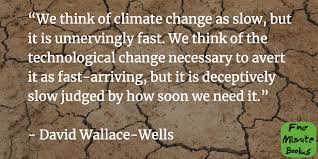 More than halfway through “The Uninhabitable Earth,” David Wallace-Wells addresses the reader directly, commending anyone who has “made it this far” for being “brave.” After all, the previous pages of his book have depicted in meticulous and terrifying detail the possible future that awaits the planet should we continue to add carbon to the atmosphere and fail to arrest global warming. Floods, pestilence, famines, wildfires: What he calls the “elements of climate chaos” are veritably biblical in scope.
More than halfway through “The Uninhabitable Earth,” David Wallace-Wells addresses the reader directly, commending anyone who has “made it this far” for being “brave.” After all, the previous pages of his book have depicted in meticulous and terrifying detail the possible future that awaits the planet should we continue to add carbon to the atmosphere and fail to arrest global warming. Floods, pestilence, famines, wildfires: What he calls the “elements of climate chaos” are veritably biblical in scope.
Wallace-Wells is a deputy editor of New York magazine, where two years ago he published an article on climate change that went viral, understandably so; in 7,000 eloquent words, he bluntly laid out the calamitous costs of doing nothing — or, perhaps more realistically and therefore more menacingly, of doing something but not enough.
His new book revisits that approach, expanding his portrait of a planetary nightmare that, to judge by climatologists’ assessments, will soon take over our waking life. The crumpled carcass of a bee on the cover tells you only some of what you need to know. Yes, apian death gets passing mention, but Wallace-Wells is more concerned with the prospect of human suffering and even extinction.
There’s plenty of science consulted here, but the book, he writes, isn’t about the science of warming: “It is about what warming means to the way we live on this planet.” He warns of collapsing ice sheets, water scarcity, an equatorial band too hot to be livable and — for anyone fortunate enough to reside elsewhere — extreme heat waves that will burn longer and kill more. All this could come with 2 degrees Celsius of warming — the threshold that world leaders pledged to stay below in the Paris accords of 2015.
Yet Wallace-Wells insists he’s optimistic; and in fact, he obtains some consolation by peering into the abyss, entertaining the worst-case scenarios of 6 to 8 degrees Celsius of warming. Given the prospect of utter annihilation, he says, the “degraded muddle” that we might still manage to eke out should count “as an encouraging future.” It would be “merely grim, rather than apocalyptic.”
Books about global warming have sounded the alarm for some time, with classic texts from writers like Elizabeth Kolbert and Bill McKibben chronicling the ways in which humans have irrevocably transformed the climate. The science is “tentative, ever-evolving,” Wallace-Wells writes, but “none of it is news.”

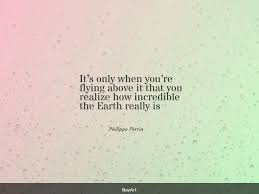 “The Uninhabitable Earth” seems to be modeled more on Rachel Carson’s “Silent Spring” — or, at least, it’s a bid to do for greenhouse gases what Carson’s 1962 book did for pesticides. “Silent Spring” became a galvanizing force, a foundational text for the environmental movement. The overarching frame for Wallace-Wells’s book is an analogous call to action: “How much will we do to stall disaster, and how quickly?”
“The Uninhabitable Earth” seems to be modeled more on Rachel Carson’s “Silent Spring” — or, at least, it’s a bid to do for greenhouse gases what Carson’s 1962 book did for pesticides. “Silent Spring” became a galvanizing force, a foundational text for the environmental movement. The overarching frame for Wallace-Wells’s book is an analogous call to action: “How much will we do to stall disaster, and how quickly?”
Part of his strategy is to tell us how much we have already lost. “The climate system that raised us, and raised everything we now know as human culture and civilization, is now, like a parent, dead,” he writes. Some of the technology we rely on to make the effects of climate change more bearable, like air-conditioning, also worsens them. The harms of global warming tend to fall disproportionately on poorer people and poorer countries, but the “cascades” already set in motion will eventually grow so enormous and indiscriminate that not even the rich will be spared.
Enough to induce a panic attack … a brutal portrait of climate change and our future lives on Earth. But we have the tools to avoid it
Mark O’Connell- Guardian

 You already know it’s bad. You already know the weather has gone weird, the ice caps are melting, the insects are disappearing from the Earth. You already know that your children, and your children’s children, if they are reckless or brave enough to reproduce, face a vista of rising seas, vanishing coastal cities, storms, wildfires, biblical floods. As someone who reads the news and is sensitive to the general mood of the times, you have a general sense of what we’re looking at. But do you truly understand the scale of the tribulations we face? David Wallace-Wells, author of the distressingly titled The Uninhabitable Earth, is here to tell you that you do not. “It is,” as he puts it in the book’s first line, “worse, much worse, than you think.”
You already know it’s bad. You already know the weather has gone weird, the ice caps are melting, the insects are disappearing from the Earth. You already know that your children, and your children’s children, if they are reckless or brave enough to reproduce, face a vista of rising seas, vanishing coastal cities, storms, wildfires, biblical floods. As someone who reads the news and is sensitive to the general mood of the times, you have a general sense of what we’re looking at. But do you truly understand the scale of the tribulations we face? David Wallace-Wells, author of the distressingly titled The Uninhabitable Earth, is here to tell you that you do not. “It is,” as he puts it in the book’s first line, “worse, much worse, than you think.”
The book expands on a viral article, also titled The Uninhabitable Earth, which Wallace-Wells published in New York in the summer of 2017, and which frightened the life out of everyone who read it. Writing at length, he is even more remorseless in his delineation of what the not nearly distant enough future probably holds for us. The book’s longest section, entitled Elements of Chaos, is composed of 12 short and brutal chapters, each of which foretells a specific dimension of our forecast doom, and whose titles alone – Heat Death; Dying Oceans; Unbreathable Air; Plagues of Warming – are enough to induce an honest-to-God panic attack.
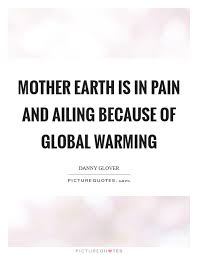
 Wallace-Wells identifies a tendency, even among those of us who think we are already sufficiently terrified of the future, to be strangely complacent about the figures. Yes, we know that climate change will cause sea level rises of between four to eight feet before the end of this century, but then again what’s a few feet if you happen to live a couple of miles inland? “That so many feel already acclimated to the prospect of a near-future world with dramatically higher oceans,” he writes, “should be as dispiriting and disconcerting as if we’d already come to accept the inevitability of extended nuclear war – because that is the scale of devastation the rising oceans will bring.”
Wallace-Wells identifies a tendency, even among those of us who think we are already sufficiently terrified of the future, to be strangely complacent about the figures. Yes, we know that climate change will cause sea level rises of between four to eight feet before the end of this century, but then again what’s a few feet if you happen to live a couple of miles inland? “That so many feel already acclimated to the prospect of a near-future world with dramatically higher oceans,” he writes, “should be as dispiriting and disconcerting as if we’d already come to accept the inevitability of extended nuclear war – because that is the scale of devastation the rising oceans will bring.”
The book is extremely effective in shaking the reader out of that complacency. Some things I did not want to learn, but learned anyway: every return flight from London to New York costs the Arctic three square metres of ice; for every half degree of warming, societies see between a 10 and 20% increase in the likelihood of armed conflict; global plastic production is expected to triple by 2050, by which point there will be more plastic than fish in the planet’s oceans. The margins of my review copy of the book are scrawled with expressions of terror and despair, declining in articulacy as the pages proceed, until it’s all just cartoon sad faces and swear words.
There is a widespread inclination to think of climate change as a form of compound payback for two centuries of industrial capitalism. But among Wallace-Wells’s most bracing revelations is how recent the bulk of the destruction has been, how sickeningly fast its results. Most of the real damage, in fact, has taken place in the time since the reality of climate change became known. And we are not slowing down. One of the sentences I found most upsetting in this book composed almost exclusively of upsetting sentences: “We are now burning 80% more coal than we were just in the year 2000.”
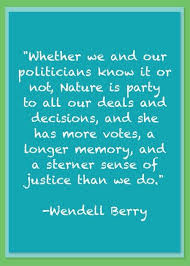
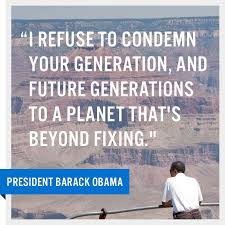 There’s also a temptation, when thinking about climate change, to focus on denialism as the villain of the piece. The bigger problem, Wallace-Wells points out, is the much vaster number of people (and governments) who acknowledge the true scale of the problem, and still act as if it’s not happening. Outright climate denialism as a political force, he argues, is essentially a US phenomenon – which is to say, essentially, a phenomenon of the Republican party – and the US is responsible for only 15% of the world’s emissions. “To believe the fault for global warming lies exclusively with the Republican party or its fossil-fuel backers is a form of American narcissism.” (I’m not sure I’ve ever heard anyone make quite so simplistic a case, but the point about denialism as largely a red herring is an important one.)
There’s also a temptation, when thinking about climate change, to focus on denialism as the villain of the piece. The bigger problem, Wallace-Wells points out, is the much vaster number of people (and governments) who acknowledge the true scale of the problem, and still act as if it’s not happening. Outright climate denialism as a political force, he argues, is essentially a US phenomenon – which is to say, essentially, a phenomenon of the Republican party – and the US is responsible for only 15% of the world’s emissions. “To believe the fault for global warming lies exclusively with the Republican party or its fossil-fuel backers is a form of American narcissism.” (I’m not sure I’ve ever heard anyone make quite so simplistic a case, but the point about denialism as largely a red herring is an important one.)
It’s easy to overlook how bad things have got, to accept the floods, wildfires and hurricanes as the nature of things
This all makes for relentlessly grim reading, particularly in that first section. As is generally the case in any sustained exposure to the subject of climate change – a subject that can seem increasingly like the only subject – a kind of apocalyptic glaze descends over even the most conscientious eyes, a peculiarly contemporary compound of boredom and horror. (“Human kind,” as the bird in TS Eliot’s Four Quartets sagely points out, “cannot bear very much reality.”) It’s a problem of which Wallace-Wells is clearly aware. “If you have made it this far, you are a brave reader,” as he puts it, somewhere past the halfway point, acknowledging the likelihood of the material he’s sifting through causing despondency in anyone considering it. “But you are not merely considering it,” he clarifies, “you are about to embark on living it. In many cases, in many places, we already are.”
That last point turns out to be one of the most crucial of the book’s warnings. Because as dire as the projections are, if you are surveying the topic from a privileged western vantage, it’s easy to overlook how bad things have already got, to accept the hurricanes and the heatstroke deaths as simply the unfortunate nature of things. In this way, Wallace-Wells raises the disquieting spectre of future normalisation – the prospect that we might raise, incrementally but inexorably, our baseline of acceptable human suffering. (This phenomenon is not without precedent. See, for example, the whole of human history.)
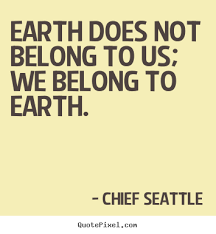 For a relatively short book, The Uninhabitable Earth covers a great deal of cursed ground – drought, floods, wildfires, economic crises, political instability, the collapse of the myth of progress – and reading it can feel like taking a hop-on hop-off tour of the future’s sprawling hellscape. It’s not without its hopeful notes: in a sense, none of this would even be worth talking about if there were nothing we could do about it. As Wallace-Wells points out, we already have all the tools we need to avoid the worst of what is to come: “a carbon tax and the political apparatus to aggressively phase out dirty energy; a new approach to agricultural practices and a shift away from beef and dairy in the global diet; and public investment in green energy and carbon capture”. The fact that the route out of this hell is straightforward does not mean, of course, that it won’t be incredibly arduous, or that we should be confident of making it.
For a relatively short book, The Uninhabitable Earth covers a great deal of cursed ground – drought, floods, wildfires, economic crises, political instability, the collapse of the myth of progress – and reading it can feel like taking a hop-on hop-off tour of the future’s sprawling hellscape. It’s not without its hopeful notes: in a sense, none of this would even be worth talking about if there were nothing we could do about it. As Wallace-Wells points out, we already have all the tools we need to avoid the worst of what is to come: “a carbon tax and the political apparatus to aggressively phase out dirty energy; a new approach to agricultural practices and a shift away from beef and dairy in the global diet; and public investment in green energy and carbon capture”. The fact that the route out of this hell is straightforward does not mean, of course, that it won’t be incredibly arduous, or that we should be confident of making it.
The book, however, is less focused on solutions than on clarifying the scale of the problem, the horror of its effects. You could call it alarmist, and you would not be wrong. (In the closing pages, Wallace-Wells himself accepts the charge as “fair enough, because I am alarmed”.) But to read The Uninhabitable Earth – or to consider in any serious way the scale of the crisis we face – is to understand the collapse of the distinction between alarmism and plain realism. To fail to be alarmed is to fail to think about the problem, and to fail to think about the problem is to relinquish all hope of its solution.
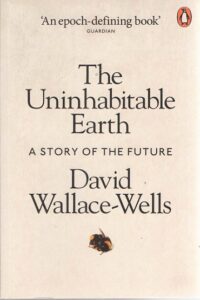
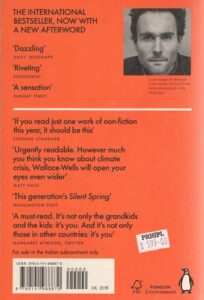
0 thoughts on “The Uninhabitable Earth: A Story Of The Future”